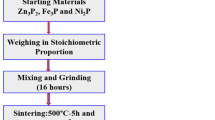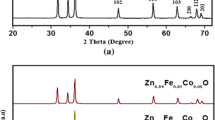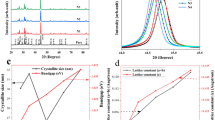Abstract
Manganese and iron (Mn–Fe) co-doped with zinc phosphide (Zn(3−(x+y)) MnxFeyP2, x = 0.02, y = 0.02,0.04,0.06, and 0.08) nanoparticles were synthesised by a solid-state method. Structural, morphological, composition, optical, photoluminescence, and magnetic properties were investigated. The characterization techniques such as XRD (X-ray diffraction), SEM (Scanning electron microscopy), EDS (Energy dispersive X-ray spectroscopy), UV-Vis–NIR spectroscopy (Ultraviolet–Visible near-infrared region), PL (Photoluminescence), and VSM (Vibrating sample magneto meter) were employed to explore the obtained nanoparticles. The XRD analysis revealed that co-doped samples showed a tetragonal structure and no secondary phase peaks were observed in the diffraction patterns. Lattice parameters increase from a = b = 8.0211 Å, c = 11.4048 Å to a = b = 8.1408 Å, c = 11.4629 Å with increasing dopant concentration. The SEM study revealed that the size of agglomerations slightly increases with increasing dopant concentration. The elemental analysis confirmed that all the Mn-Fe co-doped Zn3P2 nanoparticles are nearly stoichiometric. The diffuse reflectance spectra were used to calculate the optical bandgap of the Mn-Fe codoped Zn3P2 nanoparticles and it increased with increase of dopant concentration (1.412–1.425 eV). PL studies confirmed all emission peaks are in the same wavelength position and slight intensity changes with increasing dopant concentration. The M–H hysteresis loop of the pure and Mn-Fe co-doped Zn3P2 nanoparticles shows weak ferromagnetism changing to strong ferromagnetism with the increase in dopant concentration. Magnetic moment obtained from the present studies suggests that the Mn–Fe co-doped Zn3P2 nanoparticles may be a useful material in semiconductor spintronics.









Similar content being viewed by others
Data availability
Data will be made available on reasonable request. The data that support the findings of this study are available from the corresponding author upon reasonable request.
References
M.K. Jain, Diluted magnetic semiconductors (World Scientific, New Jersey, 1991)
M.S. Khan, L. Shi, B. Zou, Sajjad, Theoretical investigation of optoelectronic and magnetic properties of co-doped ZnS and (Al, Co) co-doped ZnS. Comput. Mater. Sci. 174, 109491 (2020). https://doi.org/10.1016/j.commatsci.2019.109491
G.A. Prinz, Magneto electronics. Science. 282, 1660–1663 (1998). https://doi.org/10.1126/science.282.5394.1660
I. Zutic, J. Fabian, S. Das Sarma, Spintronics: fundamentals and applications. Rev. Mod. Phys. 76, 323 (2004). https://doi.org/10.1103/RevModPhys.76.323
D.V. Sridevi, R. Vadivel, S. Perumal, E. Sundaravadivel, V. Sivaramakrishnan, A facile synthesis of Mn-doped ZnSe nanoparticles for an enhanced photocatalytic activity and biological applications. Ceram. Int. 48, 29394–29402 (2022). https://doi.org/10.1016/j.ceramint.2022.06.050
Y. Zhang, W. Liu, H. Niu, Half-metallic ferromagnetism in Cr-doped AlP—density functional calculations. Solid State Commun. 145, 590–593 (2008). https://doi.org/10.1016/j.ssc.2007.12.022
W.B. Mi, E.Y. Jiang, H.L. Bai, Structure, magnetic and optical properties of polycrystalline co-doped TiO2 films. J. Magn. Magn. Mater. 321, 2472–2476 (2009). https://doi.org/10.1016/j.jmmm.2009.03.017
A. Ait Raiss, Y. Sbai, L. Bahmad, A. Benyoussef, Magnetic and magneto-optical properties of doped and co-doped CdTe with (Mn, Fe): Ab-initio study. J. Magn. Magn. Mater. 385, 295–301 (2015). https://doi.org/10.1016/j.jmmm.2015.02.077
K.H. Kim, K.J. Lee, D.J. Kim, C.S. Kim, H.C. Lee, C.G. Kim, S.H. Yoo, H.J. Kim, Y.E. Ihm, Improvement of magnetic property of GaMnN by codoping of mg. J. Appl. Phys. 93, 6793–6795 (2003). https://doi.org/10.1063/1.1556114
S. Bhuvana, H.B. Ramalingam, G. Thilakavathi, K. Vadivel, Structural, optical and magnetic properties of (Ni–Mn) co-doped tin oxide nanoparticles. Matte Technol. 32, 305–309 (2017). https://doi.org/10.1080/10667857.2016.1215088
M. von Stackelberg, R. Paulus, Z. Phys. Chem. 28, 421 (1935)
J.M. Pawlikowski, Absorption edge of Zn3P2. Phys. Rev. B 26, 4711 (1982). https://doi.org/10.1103/PhysRevB.26.4711
A. Catalano, V. Dalal, W.E. Devaney, E.A. Fagen, R.B. Hall, J.V. Masi, J.D. Meakin, G. Warfield, N. Convers Wyeth, A.M. Barnett, Zn3P2 —a promising photovoltaic material. 13 th Photovoltaic Specialists Conference. 288–293 (1978)
Y. Kato, S. Kurita, T. Suda, Photoenhanced chemical vapor deposition of zinc phosphide. J. Appl. Phys. 62, 3733–3739 (1987). https://doi.org/10.1063/1.339257
M. Peiteado, T. Jardiel, F. Rubio, A.C. Caballero, Multipod structures of ZnO hydrothermally grown in the presence of Zn3P2. Mater. Res. Bull. 45, 1586–1592 (2010). https://doi.org/10.1016/j.materresbull.2010.07.026
N. Convers Wyeth, A. Catalano, Spectral response measurements of minority-carrier diffusion length in Zn3P2. J. Appl. Phys. 50, 1403–1407 (1979). https://doi.org/10.1063/1.326122
T. Suda, T. Miyakawa, S. Kurita, Zinc Phosphide thin films grown by RF sputtering. J. Cryst. Growth. 86, 423–435 (1988). https://doi.org/10.1016/0022-0248(90)90754-9
R.P.N. Humblot, S.E. Steinvall, E.Z. Stutz, S.S. Joglekar, J.-B. Leran, M. Zamani, C. Cayron, R. Logé, Andres Granados Del Aguila, Qihua Xiong, and Anna Fontcuberta i Morral, Van Der Waals epitaxy of earth-abundant Zn3P2 on graphene for photovoltaics. Cryst. Growth Des. 20, 3816–3825 (2020). https://doi.org/10.1021/acs.cgd.0c00125
P.S. Sadanand, P.K. Babu, A.K. Singh, D.K. Thakur, Dwivedi, Optimization of photovoltaic solar cell performance via the earth abundant Zn3P2 back surface field. Optik. 229, 166235 (2021). https://doi.org/10.1016/j.ijleo.2020.166235
M. Zamani, E. Stutz, S. Escobar, R.R. Zamani, R. Paul, J.-B. Leran, The path towards 1 µm monocrystalline Zn3P2 films on InP: substrate preparation, growth conditions and luminescence properties. J. Phys. Energy 3, 034011 (2021).
S.E. Steinvall, Z. Elias, R. Stutz, M. Paul, J.-B. Zamani, Leran, Nanoscale growth initiation as a pathway to improve the earth-abundant absorber zinc phosphide. ACS Appl. Energy Mater. 5, 5298–5306 (2021). https://doi.org/10.1021/acsaem.1c02484
R.P.S.W. Tabernig, J.R. Sapera, J. Hurni, A. Tiede, X. Liu, A. Djamshid, Carrier generation and collection in Zn3P2/InP heterojunction solar cells. Sol Energy Mater. Sol Cells 256, 112349 (2023). https://doi.org/10.1016/j.solmat.2023.112349
Z. Elias, S.P. Stutz, M. Ramanandan, R. Flor, M. Paul, S.E. Zamani, A.P. Steinvall, Stoichiometry modulates the optoelectronic functionality of zinc phosphide (Zn 3−xP 2+x). Faraday Discuss (2022). https://doi.org/10.1039/D2FD00055E
X. Li, W.L. Jiale, H. Yu, Z. Zhang, Shi, Z. Guo, Self-supported Zn3P2 nanowires-assembly bundles grafted on Ti foil as an advanced integrated electrodes for lithium/sodium ion batteries with high performances. J. Alloys Compd. 724, 932–939 (2017). https://doi.org/10.1016/j.jallcom.2017.07.016
I.J. Paredes, C. Beck, S. Lee, S. Chen, M. Khwaja, M.R. Scimeca, S. Li, S. Hwang, Z. Lian, K.M. McPeak, S.F. Shi, Synthesis of luminescent core/shell α-Zn3P2/ZnS quantum dots. Nanoscale 12, 20952–20964 (2020)
E.Z. Stutz, SESteinvall. Steinvall, A.P. Litvinchuk, J.B. Leran, M. Zamani, R. Paul, A.F. Morral, M. Dimitrievska, Raman spectroscopy and lattice dynamics calculations of tetragonally-structured single crystal zinc phosphide (Zn3P2) nanowires. Nanotechnology 32, 085704 (2020).
R. Laiho, K.G. Lisunov, E. Lahderanta, V.S. Zakhvalinskii, Magnetic MnAs nanoclusters in the diluted magnetic semiconductor (Zn1 – xMnx)3As2. J. Phys. Condens. Matter. 11, 8697 (1999)
C.J.M. Denissen, H. Nishihara, J.C. Van Gool, W.J.M. De Jonge, Magnetic behavior of the semimagnetic semiconductor (Cd1 – xMnx)3As2. Phys. Rev. B 33, 7637 (1986). https://doi.org/10.1103/PhysRevB.33.7637
G. Jaiganesh, S. Mathi Jaya, Electronic structure and magnetism of titanium substituted Cd3P2: An ab-initio study. AIP conference proceedings. AIP Conf. Proc. (1953). https://doi.org/10.1063/1.5033127
G. Jaiganesh, S. Mathi Jaya, Half-metallic ferromagnetism in Fe-doped Zn3P2 from first-principles calculations. AIP Conf. Proc. Am. Inst. Phys. 1591, 1081–1083 (2014). https://doi.org/10.1063/1.4872860
G. Jaiganesh, S. Mathi Jaya, Effect of partial Ti substitution at Zn sites on the structural, electronic and magnetic properties of Zn3P2. Authorea Preprints (2020). https://doi.org/10.22541/au.160466779.91279508/v1
G. Jaiganesh, S. Mathi Jaya, Magnetism, electronic structure and half-metallic property of transition metal (V, cr, Mn, Fe, Co) substituted Zn3P2 dilute magnetic semiconductors: an ab-initio study. Comput. Mater. Sci. 102, 85–94 (2015). https://doi.org/10.1016/j.commatsci.2015.02.018
N. Praveenkumar, N. Madhusudhana Rao, Ni doped Zn3P2 nanoparticles: synthesis, structural, optical, and magnetic properties. J. Supercond. Novel Magn. (2023). https://doi.org/10.1007/s10948-023-06670-w
R. Ashraf, S. Riaz, M. Bashir, U. Khan, S. Naseem, Structural and magnetic properties of Mn/Fe co-doped ZnO thin films prepared by sol–gel technique. IEEE Trans. Magn. 50, 1–4 (2014). https://doi.org/10.1109/TMAG.2014.2305670
B.D. Cullity, Answers to problems: elements of X-ray diffraction (Addison-Wesley Publishing Company, London, 1978)
K. Chaitanya Kumar, N. Madhusudhana Rao, S. Kaleemulla, G. Venugopal Rao, Structural, optical and magnetic properties of Sn doped ZnS nanopowders prepared by solid-state reaction. Phys. B Condens. 522, 75 (2017). https://doi.org/10.1016/j.physb.2017.07.071
M. Bhushan, J.A. Turner, B.A. Parkinson, Photoelectrochemical Investigation of Zn3P2. J. Electrochem. Soc. 133, 536 (1986). https://doi.org/10.1149/1.2108615
G.M. Kimball, A.M. Muller, N.S. Lewis, H.A. Atwater, Photoluminescence-based measurements of the energy gap and diffusion length of Zn3P2. Appl. Phys. Lett. (2009). https://doi.org/10.1063/1.3225151
E. Burstein, Phys. Rev. 93, 632 (1954)
B. Poornaprakash, D. Amaranatha Reddy, G. Murali, N. Madhusudhana Rao, R.P. Vijayalakshmi, B.K. Reddy, Composition dependent room temperature ferromagnetism and PL intensity of cobalt doped ZnS nanoparticles. J. Alloys Compd. 577, 79–85 (2013). https://doi.org/10.1016/j.jallcom.2013.04.106
Y.G. Yoo, Ferromagnetism-to-paramagnetism transition in the ZnMnO system. J. Korean Phys. Soc. 52, 1398–1401 (2008)
S.F. Marenkin, V.M. Trukhan, I.V. Fedorchenko, S.V. Trukhanov, T.V. Shelkovaya, Magnetic and electrical properties of Zn3P2 + MnP materials. Inorg. Mater. 49, 545–549 (2013). https://doi.org/10.1134/S0020168513050087
L. Yan, C.K. Ong, C. K., X.S. Rao, Magnetic order in co-doped and (Mn, Co) codoped ZnO thin films by pulsed laser deposition. J. Appl. Phys. 96, 508–511 (2004). https://doi.org/10.1063/1.1757652
Acknowledgements
The authors acknowledge VIT-AP’s financial assistance provided via the RGEMS. The authors also give credit to VIT-AP University for analyzing UV–Vis–NIR data. YU-University in Kadapa for XRD, and SEM with EDAX analysis. For helping to record the PL spectra used in the current investigation, the authors are grateful to Dr. Jayasimhadri from the Department of Physics at Delhi Technological University, India. The authors also thank SAIF-IIT Madras for providing vibrating sample magnetometer (VSM) facilities.
Funding
The authors declare that no funds, grants, or other support were received during the preparation of this manuscript.
Author information
Authors and Affiliations
Contributions
NPK carried out the synthesis, characterizations and writing. NPK and MRN discussed the results and commented on the manuscript.
Corresponding author
Ethics declarations
Conflict of interest
Authors declares that there is no conflict of interest involve in the current work.
Ethical approval
This article does not contain any studies with human participants or animals performed by any of the authors. In this experiment, we did not collect any samples of human and animals.
Additional information
Publisher’s Note
Springer Nature remains neutral with regard to jurisdictional claims in published maps and institutional affiliations.
Rights and permissions
Springer Nature or its licensor (e.g. a society or other partner) holds exclusive rights to this article under a publishing agreement with the author(s) or other rightsholder(s); author self-archiving of the accepted manuscript version of this article is solely governed by the terms of such publishing agreement and applicable law.
About this article
Cite this article
Praveenkumar, N., Madhusudhana Rao, N. Synthesis of (Mn, Fe) co-doped Zn3P2 nanoparticles: structural, optical and magnetic properties via solid-state reaction route. J Mater Sci: Mater Electron 35, 719 (2024). https://doi.org/10.1007/s10854-024-12512-9
Received:
Accepted:
Published:
DOI: https://doi.org/10.1007/s10854-024-12512-9




